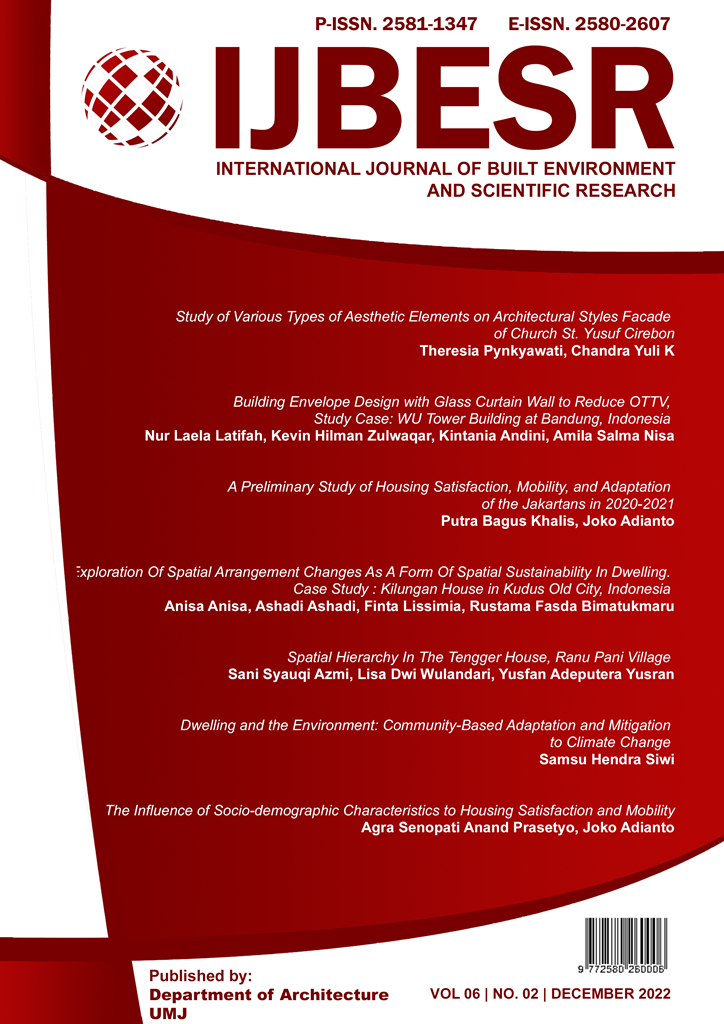EXPLORATION OF SPATIAL ARRANGEMENT CHANGES AS A FORM OF SPATIAL SUSTAINABILITY IN DWELLING. Case Study : Kilungan House in Kudus Old City, Indonesia
DOI:
https://doi.org/10.24853/ijbesr.6.2.127-138Keywords:
change, spatial arrangement, spatial sustainability, occupancyAbstract
Space is an architectural form that is used to accommodate activities with certain functions. In a space contained activities carried out by humans and functions that represent these activities. Sometimes during this period the space undergoes changes in activity and function. Space can undergo physical and non-physical changes to respond to changes in these activities and functions. Kilungan is a local term used to refer to the tall massive fence in the Old City of Kudus. The massive fence, known as the kilungan, was built with one of the goals to provide a sense of security. Inside the kilungan house, there are at least 2 main building masses, namely the main house and the supporting buildings. The spaces in the kilungan house which have been inhabited for more than 100 years have also undergone changes in response to the spatial sustainability of the dwelling. The purpose of this study is to explore, describe, and get the meaning of changes in space in the kilungan house. This study uses an inductive qualitative method. The initial stage is to make observations to get the distribution of the kilungan house. The research area is limited to the Old City of Kudus, Indonesia. The core stage of the research is data collection and analysis carried out simultaneously inductively. Exploration is carried out on cases to obtain findings in accordance with research objectives. The results of this study were found changes in spatial arrangement in the kilungan house in the form of: (1) changes in function without changing the physical form of space, found in spaces that accommodate different activities but have the same activity pattern; (2) changing the function of changing the spatial arrangement without changing the mass of the building; (3) changes in spatial arrangement change the physical building; (4) shifting activity changes zoning (5) Determining the direction of change does not change the orientation of the building in the circle. ; (6) Spatial sustainability in residential areas is indicated by changes in activities, functions, spatial arrangement but does not change the core things which are the concept of the kilungan house. Spatial sustainability can be found in the adaptations made by building users to new functions in the spaces in the dwelling.References
Sativa, Bakti Setiawan, Djoko Wijono, MG Adiyanti. (2017). Variasi Setting Fisik Ruang Interaksi Anak di Kampung Padat Kota Yogyakarta. INERSIA Vol XIII No 2 Desember 2017
https://journal.uny.ac.id/index.php/inersia/article/view/17180
Anisa. (2004). Rumah di dalam kilungan di Kota Lama Kudus. NALARs Vol 3 No 1 Januari 2004.
Hillier, Bill and Hanson, Julierne. (1984). The Social Logic of Space. Cambridge University Press.
Anisa dan Nuraini, Ratna Dewi. (2020). Kajian Aspek Vernakularitas pada Rumah Kilungan di Kota Lama Kudus. NALARs Vol 19 No 2 Juli 2020. https://jurnal.umj.ac.id/index.php/nalars/article/view/6465/4268
Anisa dan Finta Lissimia. (2021). Identification of Building Arrangements in Vernacular Residential : The Case of houses in Kudus Old City. Prosiding ICECREAM#1 International Conference on Engineering, Construction, renewable Energy and Adzance Material
https://jurnal.umj.ac.id/index.php/icecream/article/view/11560
Setyowati, erni dan Setioko, Bambang. (2013). Buku ajar Metodologi Riset dan statistik : Metodologi Penelitian Kualitatif dan Kuantitatif. UNDIP Press
Wikantari, Ria Rosalia dan Narumi. (1999). Preserving wooden Traditional Houses Through Community Empowerment : the case of an historic area of Kudus, Indonesia. Proceedings on Vernacular Settlement : The role of Local Knowledge in Built Environment.
Ashadi, Anisa, Ratna Dewi Nur’aini. (2018). Penerapan Metode Kuantitatif dan Kualitatif dalam Penelitian Arsitektur. Arsitektur UMJ Press.
Bungin, Burhan. (2021). Social Research Methods :Kuantitatif, Kualitatif, Mixed Methods. Penerbit Kencana
Sesotyaningtyas, Mega dan Wiwik D Pratiwi. (2021). Transformasi Spasial Peri-Urban di Sekitar Sungai Ciliwung dan Keberlanjutan Kegiatan Wisata Berbasis Sungai. Ruang : Jurnal Lingkungan Binaan Vol 8 No 1 April Tahun 2021
https://ojs.unud.ac.id/index.php/ruang/article/view/61806
Wulung, Shandra Rama Panji. (2021). Pendekatan Spasial untuk Pengembangan Destinasi Pariwisata. Jurnal Tornare Vol 3 No 2 Mei 2021
https://jurnal.unpad.ac.id/tornare/article/view/32657/15421
Snyder, James C dan Anthony James Catanese, (1989). Pengantar Arsitektur. Penerbit Erlangga.
Kusumastuti, Agnes Laras, Istijabatul Aliyah, Rara Sugiarti. (2019). Manajemen Spasial Bagi Keberlanjutan Destinasi Wisata Budaya (Studi Kasus : Kampung Batik Laweyan) . Jurnal Cakra Wisata Vol 20 No 1 Tahun 2019
https://jurnal.uns.ac.id/cakra-wisata/article/view/34010/22408







